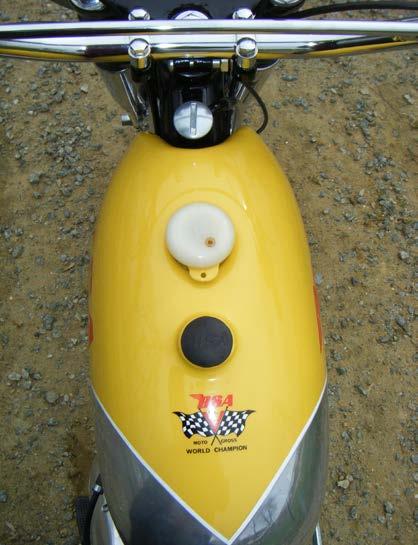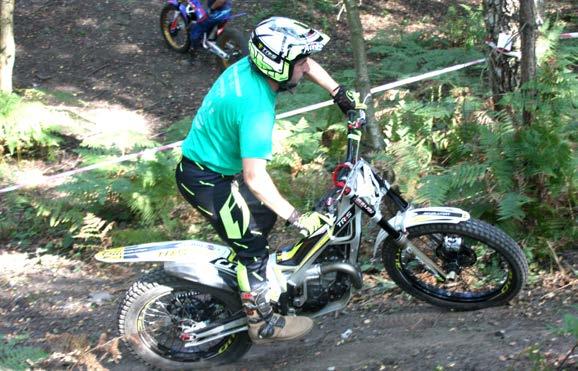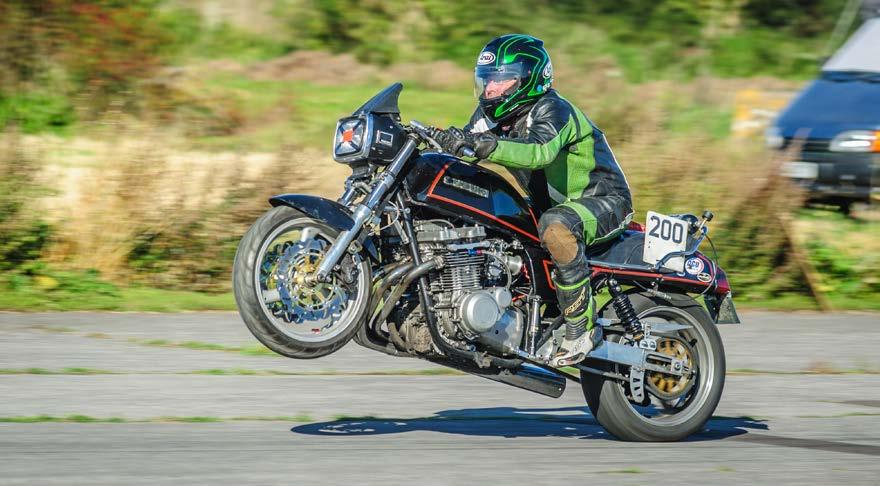
10 minute read
BSA Victor GP 441cc (Tales of the Unexpected?)
By Dave Blanchard
The BSA Victor B44 Grand Prix is universally renowned as the ultimate sixties scrambles bike. But it was Jeffrey Vincent Smith who championed it and was also heavily involved in its development. Birmingham Small Arms had unbelievably taken the humble ride to work C15 Star and over a period of time turned it into a world beating Moto Cross machine admired and envied by the manufacturing opposition.
Advertisement
This "Victorious Scrambler" took Jeff (BSAs top "Star Rider" at the time) to two consecutive world championships, in 1964 and 1965.
The bike featured here left the Armoury Road factory at Small Heath on the 3rd of May 1967. It was bound for the BSA dealers "Colebrooks Motorcycles" in Saint Helier Jersey, the largest of our Channel Islands. John Marchant had seen it advertised and nostalgia easily cajoled him into purchasing this scrambler because as a young man he wanted to race one just like it way back in the sixties, but finances were prohibitive so an AJS 500 single fitted into the standard Gold Star chassis had to suffice. But decades later the dream of owning a Victor Grand Prix came true. This emotionally inspired deal was finally clinched on Boxing Day 2012. We must all remember to buy ourselves a "belated Christmas Present" next year, just like John did!
The very first owner of the bike sadly never rode it in a competition. So why did he buy it? Perhaps it was because it looked so handsome and capable, or did he just want to own a bike that oozed world championship pedigree with all the status that it would command? We will probably never know the true reason.
After just two more Channel Island owners it was sailing its way back to England but this time to the South East because John was now the slightly apprehensive but excited new owner.
The life of a competition bike (or any bike) could possibly be easier on the Island of Jersey due to the drier continental climate, but Jersey is also famous for sand racing on its beautiful long beaches, so quite probably this is where it would have been used for most of its early life. Sand and beach salt can be a killer to all things mechanical but the Victor since leaving Birmingham, had obviously lead a sheltered and minimalist competition life, so was in very good mechanical fettle considering its original intended purpose. Cosmetic is the current word we use to describe the finish on the bicycle parts and these were in need of some attention. Winning best scrambles bike award at the December 2013 "Kempton Off-Road Show" confirms this rebuild as top notch. It is so well buffed up that it could easily dazzle the opposition during a race heat or maybe whilst revving up on the start line waiting for the starter's Union flag to fall to send them on their thundering way. Can't you just hear that deafening roar! A recreational drug for the ear drums perhaps?
I understated that easy competition life that the Victor has had because when John completely stripped the engine to check the internals including the transmission, it was almost like new! In such unbelievably good condition in fact, that even the standard piston rings were retained! Now how often does that happen? Never in my refurbishing experience! Although John did admit to changing the kick starter lever and its corresponding shaft, including of course the obligatory new cotter pin. Those quick to wear decompressor parts in the cylinder head were missing and the hole was blanked off. So John replaced those parts along with the corresponding handlebar lever and cable. The gearbox sprocket was also changed but not because it was worn; it just had too many teeth on it, (unlike me). With the correct 16 tooth Victor Grand Prix final drive sprocket fitted the gearing was now lowered and back to standard specifications. You will find this hard to believe but the chains were in good condition as well, so just a clean and lube was needed. Whether these are the original chains fitted at Small Heath or not it is very hard to say. But we can assume that chains could not have lasted that long, unless the bike had spent most of its life in a continental showroom. If only scrambles bikes had odometers fitted back then, this could have given provenance to their originality. Now that would be absolutely amazing if proven!
As an aid to starting this 11.4 to 1 high compression long stroke single, a modern electronic box of tricks was fitted to force those extra volts down the HT lead, where they would smartly jump across the spark plug electrodes. A long stroke single on a modern unit construction engine did I just state? Yes that's correct, with a bore of 79mm and a whopping 90mm stroke this is certainly an old fashioned engine configuration, but externally it gives the appearance of being at least square. Old fashioned it may seem but the usable power it produced wasn't lacking, especially when all it had to pull was a claimed weight of 255lbs. Plus the fully kitted out pilot of course!
The ubiquitous "Monobloc" carburettor was the standard 1inch and five thirty seconds bore as fitted to the Victor by those knowledgeable "Brummy" production line workers at BSA back in 1967. This too was in great condition for its age. But! New air filters were needed (there are 2 of them). Incredibly some items do not last forever, even though at times we wished they would.
John's newly acquired B44 Victor had probably seen the heat of battle at some time in the past. To back up this proof the bike came with 2 front wheels. The one fitted was a 21 inch, the other wheel was the correct 20 inch one as originally specified by Small Heath. Due to the scarcity of 20 inch competition tyres back then, riders would automatically upgrade to a 21 inch front rim solely because that tyre size was plentiful. So John's Victor GP has clearly been used for competition at some time in its life.

Tatty wheels can spoil a great bike, so John had new rims, spokes and tyres fitted by Tony Cook which really enhance the finished machine.
Brakes and hubs were stripped, checked, cleaned then painted before respoking of course.
I know this seems a little unreal but even the brake linings did not need renewing! How uncannily spooky is that!
A new front bracket was made to retain the seat and the seat was treated to a brand new cover no matter what the expense. The fibreglass base and foam rubber were in perfect condition but scrambles riders do stand up quite frequently which saves on wear and tear.
While the wheels were away for rebuilding the frame had been completely stripped down. The Reynolds 531 tubed frame would be treated to some durable powder coating, while shiny black 2 pack was applied to other parts that needed to look beautiful.

Incidentally, this is an oil carrying frame with a small, flat "oil header tank" fixed between the two seat down tubes. The front fork top bearing was renewed as well as the fork oil seals and holders.
The almost unmarked petrol tank got a new retaining bracket and a plastic bung to cover the retaining bolt. Cosmetically (there's that word again) the tank was embellished with a few coats of (Victory?) yellow and some new transfers. The transfer at the rear of the petrol tank clearly boast's "BSA 500cc Moto Cross World Champion" the wording arranged around 2 crossed chequered flags for greater effect. A new rubber retaining strap for the front number plate was another of the parts to be fitted shortly before the completion of this fairly straight forward resurrection of a champion's steed.
New handlebars, controls and cables left nothing to chance and would match the overall standard of the finished rebuild. One of the final purchases was a chromium plated front mudguard stay. Oh yes I had almost forgotten about that original curvy exhaust pipe that tucks itself so unobtrusively over the timing case, then fiddles its way behind the frame tubes to exit into a newly made barrel shaped silencer defined by BSA as a megaphone. Not the most technical looking of exhaust systems externally, but BSA boys are a canny lot you know and you can bet your bottom Euro that those exhaust gases would exit very rapidly as per gas flow design.
When it was time for the photo shoot I approached the Sidcup & District Motorcycle Club to see if we could take the pictures at their famous Canada Heights Scrambles course in Swanley, Kent. A better and more accommodating bunch of enthusiasts would be extremely hard to find so we must give sincere thanks to these club men and ladies for allowing us the access needed. The backdrop at this historic circuit was spot on!
If you are "fifty something" you will probably remember the revered "BBC Grandstand Trophy" motor cross series viewed mainly on small screened monochrome television sets in the sixties and very early seventies. Canada Heights was an important host to many of the competitive rounds and local boy Vic Eastwood could be seen here riding his AMCs, but eventually, even he defected to ride the much lighter and proven world championship winning BSA Victor Grand Prix scrambles iron. Victor Eastwood quite often rode under racing number 7. So John's bike is a tribute to him by also wearing the number 7.
So what is it like to ride a Victor Grand Prix today? What does it sound like and how does it handle?
Mechanically the engine on this particular bike is unexpectedly quiet for a competition machine. A tappet noise could be heard but the engine hasn't settled down yet so future adjustments could quieten this motor even further. The chrome plated bore of the alloy barrel would normally magnify mechanical piston slap but none could be heard. The megaphone exhaust had a healthy bark but was not too obtrusive for our aged and wrinkly human ears. Or maybe we just adored the sound of this four stroke single no matter how many decibels were escaping from its megaphone silencer. I think it's the latter!
The frame is compact to match the engine but footrests and controls are easy to find and that original seat is quite comfy for a scrambles bike.
As a trials rider I found the steering was not to my liking and would drop in on the locks when turning tightly to manoeuvre in the paddock. The long steering trail dimension so necessary for straight line stability at speed will do this. But when hammering over rough ground at racing speeds the Victor Grand Prix steering geometry gets into its stride and behaves admirably.
The BSA sales brochure states that the front fork stanchions are made of chrome molybdenum steel and they have specially developed internal damping units. I can honestly say that they are super smooth and exceptionally well controlled over rough undulating ground. So fluid are these Victor front forks that I rated them above my preferred AMC forks which are universally renowned for their silkiness. The rear dampers worked so unobtrusively that I hardly noticed any rise and fall. In the past the phrase "Just like riding on a featherbed" has been coined many times, so maybe "riding on a pocket sprung mattress" should be the new phrase for the 21st century? I never tried an emergency stop but have no reason to think that the seven inch single sided drums are any worse than any other period competition brakes.

So what does John think of his overseas purchase? It is everything that he expected, plus a little more. The power he considers feels like a full 500 and not the 441cc that the high domed piston displaces. Wheel spin on the sand and shingle at Canada Heights needs to be carefully controlled by sensible throttle application. Such is the torque of this yellow peril! The light weight of this model he thinks would have allowed him to up his game and possibly win him more club awards way back in those exciting and now historic scrambles races that he rode in.
Roll on next Boxing Day! I feel a belated Christmas Present to myself coming on!



